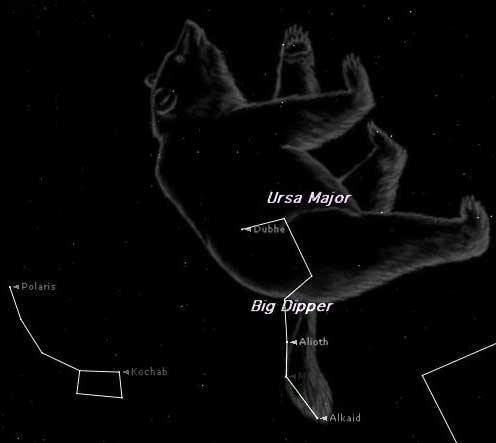
Scholars are fairly sure that the oldest of our star groups trace back to the Mesopotamian peoples of five or more millennia ago. In fact, the creatures that were made into the ancient Western constellations are similar to those in the Bible. And there are hints that some are far older.
The fact that the Big Dipper, now nearly overhead for most northern observers at around 11:30 p.m. local daylight time, formed a bear to American Indians and to cultures of the Old World and Siberia suggests that our Ursa Major is a very ancient star pattern.
Long ago, when the forms of animals and heroes were pictured against the stars, a large bear was represented in this particular region, a bear with a surprisingly long tail (because the Dipper has a long handle). In fact, it is a piece of Stone Age culture that is probably at least 8,000 to 12,000 years old. That is the estimated era of the last migration from Siberia to North America across the Bering Strait. The far-northern region of the world where this starry figure wheels high in the heavens came to be known as the Arctic region – the abode of Arktos, which in Greek literally meant bearish.
Many things
The Big Dipper itself has been a source of frustration to some constellation historians. Who exactly originated this name? For much of the world this pattern has been, if not a bear, then some sort of wagon.
In Ireland, for instance, it was recognized as "King David's Chariot," from one of that island's early kings; in France, it was the "Great Chariot." Another popular name was Charles's Wain (a wain being a large open farm wagon). In the British Isles, however, these seven stars are known widely as "The Plough."
But as a long-handled pot or ladle it is strictly an American phenomenon, first mentioned in 19th-century astronomy books, but apparently not before then. A very convincing tin dipper it is with its handle bent downward.
Get the Space.com Newsletter
Breaking space news, the latest updates on rocket launches, skywatching events and more!
Incidentally, it is wrong to refer to the Big Dipper as a constellation. There are 88 groups of stars that are officially recognized and listed as constellations. The Big Dipper, however, famous as it is, has no official status and is only recognized as being a conspicuous part of a constellation (Ursa Major). Such a star pattern is called an asterism.
How far South?
Here's an aside for our Internet friends who live south of the equator, for this is the time of year that you'll get your best views of Ursa Major and the Big Dipper. But rather than see them nearly overhead, these stars appear oriented in the northern part of the sky; the farther south one goes, the lower in the north these stars will get.
Probably the most unusual view of the Big Dipper that I ever had was when I led a Halley's Comet tour to Easter Island in early April 1986. From the south latitude of 27.1-degrees, I could see the Dipper hovering just above the northern horizon – upside down! Interestingly, back home (Putnam County, New York) in the fall, I can sight the Dipper sitting at a similar distance above my local northern horizon, but right-side-up.
The upside-down Dipper however can now be glimpsed as far south as 30-degrees south latitude, which includes many far-southerly locations, such as Johannesburg, South Africa, Asuncion, Paraguay and Sao Paulo, Brazil.
In his classic stargazing guide, "The Stars – A New Way to See Them," the late H.A. Rey sketched a cartoon of a female kangaroo with a joey in her pouch. The caption reads: "The Dipper? never seen it . . ." Yet, paradoxically, much of Australia can also see the Dipper now, as about three-quarters of the land area of that country is located above of latitude 30-degrees south. But unfortunately, most of that country's population is distributed below 30-degrees south, so the Dipper is indeed out of sight for Perth, Sydney and Melbourne. (I guess when he sketched his cartoon Mr. Rey was thinking of the Western Grey Kangaroo found only in southern parts of Australia).
About that tail . . .
But over the years, in pointing out the Great Bear to audiences either in the Space Theater of New York's Hayden Planetarium or under the real night sky, I have had to spend a minute or two trying to explain away the Bear's unusually long tail. Perhaps the most common reason given is the one attributed to the British humorist and poet, Thomas Hood (1799-1845):
"Imagine that Jupiter, fearing to come too nigh unto her teeth, layde holde on her tayle, and thereby drewe her up into the heaven; so that shee of herself being very weightie, and the distance from the Earth to the heavens very great, there was a great likelihood that her tayle must stre`tch. Other reason know I none."
Joe Rao serves as an instructor and guest lecturer at New York's Hayden Planetarium. He writes about astronomy for The New York Times and other publications, and he is also an on-camera meteorologist for News 12 Westchester, New York
Join our Space Forums to keep talking space on the latest missions, night sky and more! And if you have a news tip, correction or comment, let us know at: community@space.com.

Joe Rao is Space.com's skywatching columnist, as well as a veteran meteorologist and eclipse chaser who also serves as an instructor and guest lecturer at New York's Hayden Planetarium. He writes about astronomy for Natural History magazine, Sky & Telescope and other publications. Joe is an 8-time Emmy-nominated meteorologist who served the Putnam Valley region of New York for over 21 years. You can find him on Twitter and YouTube tracking lunar and solar eclipses, meteor showers and more. To find out Joe's latest project, visit him on Twitter.









